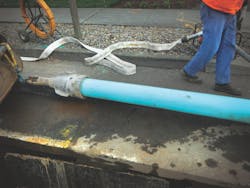Clean Water Services, a water resources management utility serving Washington County, Ore., decided to replace an aging portion of concrete sanitary sewer main in Beaverton, Ore., that was experiencing excessive tree root infiltration. Clean Water Services’ maintenance crews had in recent years, observed approximately 30 roots growing into the 355-ft, 6-in.-diameter sewer line. Keeping the roots under control was a matter that demanded constant attention.
“The major issue was the extra labor hours required for our staff to routinely spray the inside of the pipeline with foaming root killer, clean it out and do a video camera inspection,” said Gabe Sohler, field operations construction supervisor for Clean Water Services. “With such a large number of roots trying to work their way inside the pipe, there was high potential for a sanitary sewer overflow. Fortunately, the pipe was installed in the 1960s, so it was due for replacement.”
The pipe replacement presented some challenges, however, due to tight space limitations. The project site was along a narrow dead-end street with several residential and commercial driveways connected to it. Adding to this was the challenge of the street connecting to a much busier arterial road, leaving little room on the shoulder for staging equipment. Due to the constricted workspace, it was decided that static pipe bursting would be the best way to complete the project with the least disturbance to the surrounding area.
Static Pipe Bursting
Static pipe bursting utilizes hydraulically powered machinery to fracture the existing sewer or water main, or “host pipe,” with a cutting head specifically designed to cut through the host pipe material. In most cases, the cutting head is followed by an expander that disperses host pipe fragments and increases the diameter of the hole. Attached to the rear of the expander is the new replacement pipe, which is pulled in simultaneously. This process differs from pneumatic pipe bursting, a more common pipe bursting method where the bursting of the host pipe is done by a pneumatic soil displacement hammer connected to a hydraulic variable-speed winch. Due to the force exerted by the pneumatic hammer, pneumatic bursting is only recommended for use with a more flexible pipe material. Static pipe bursting, however, is compatible with virtually any type of replacement pipe, including restrained joint PVC pipe. Static pipe bursting allows jobs to be completed in significantly less time than traditional open-trench jobs with only minimal disruption to surrounding areas.
Having thousands of feet of pipe in its service area with limited surrounding space for maintenance access, Clean Water Services owns a TRIC Tools M50 static pipe bursting system, with 48 tons at 5,000 psi of pulling force. The utility’s maintenance staff was trained on the equipment to eliminate costs associated with hiring contractors.
PVC Sewer Pipe
For a replacement pipe, Clean Water Services specified CertaFlo Greenline, a high-impact PVC sewer pipe from North American Specialty Products (formerly CertainTeed Corp.’s Pipe & Foundations Group) that features the Certa-Lok Integral Bell restrained joint system. Restrained joint PVC pipe is resistant to tree root infiltration. Plus, CertaFlo pipe is available in 10-ft lengths, in addition to the standard 20-ft lengths, to allow smaller construction pit sizes in applications with confined work space.
“Due to the tight footprint of the project, the use of butt-fused HDPE pipe would have been very difficult,” Sohler said. “It would have been almost impossible to find an area close to the work site to fuse and stage the full 355 ft of pipe until it was time to pull it into the ground.”
Work began in June 2013 with a crew of four. After all of the pits were prepped and shored, the crew burst the host pipe and pulled in 355 ft of 6-in. PVC sewer pipe at depths of 4 to 5 ft in clay soil. Though it is common in pipe bursting projects to expand the annular space and replace the original pipe with a larger diameter to provide a capacity upgrade, the utility chose to stick with a 6-in. diameter. The grade of the sewer laterals was flat, so installing a larger-diameter pipe would require the extra task of raising them. The crew welded an additional skirt onto the rig’s 6-in. cutting head to make a little extra space for the new pipe’s integral bells—a modification that had proven successful in a previous project. No expander head was needed.
As another inconvenience tied to the tight workspace, the crew was required to haul all equipment off site at the end of each day and bring it back the next day to ensure that the street remained accessible to fire trucks and other emergency vehicles. Inconveniences aside, the crew was able to finish the job in a week and a half with little disturbance. The project was a success, one of many successes the utility has had in confined works spaces over the past five years with the combination of static pipe bursting and CertaFlo pipe.
“On our pipe bursting projects, CertaFlo allows us to make pit excavations three times shorter than the standard pit length required by HDPE pipe in pipe bursting applications,” Sohler said. “This reduces the amounts of spoils we have to export and rock we have to import. In addition, shorter excavations require less shoring and fewer steel plates for covering the excavation. So, the product has worked out well for us.”
Download: Here

